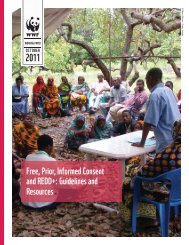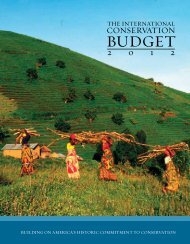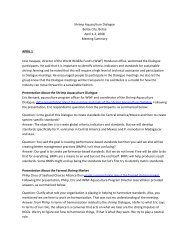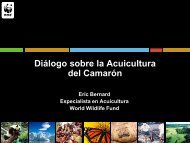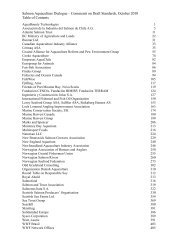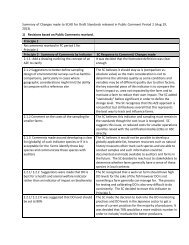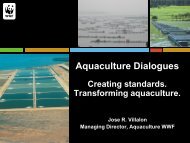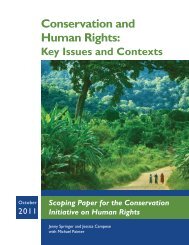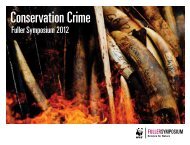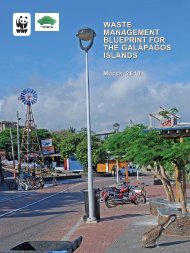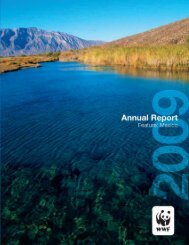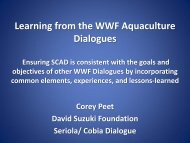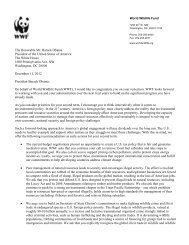A Future for Borneo & Sumatra - World Wildlife Fund
A Future for Borneo & Sumatra - World Wildlife Fund
A Future for Borneo & Sumatra - World Wildlife Fund
- No tags were found...
Create successful ePaper yourself
Turn your PDF publications into a flip-book with our unique Google optimized e-Paper software.
pulse<br />
the heart of conservation<br />
2011 / Volume 2 / Issue 1<br />
A <strong>Future</strong><br />
<strong>for</strong> <strong>Borneo</strong><br />
& <strong>Sumatra</strong><br />
Creating Hope <strong>for</strong> an<br />
Imperiled Region<br />
<strong>Borneo</strong>’s Fiery Ape<br />
Helping communities<br />
protect orangutans<br />
Global Action<br />
News on sustainable<br />
coffee, hot fish, and more
the heart of conservation<br />
3 Racing the Clock<br />
The rich biodiversity of <strong>Borneo</strong> and <strong>Sumatra</strong> is<br />
in peril. Bruce Cabarle, Dave McLaughlin and<br />
Kate Newman – WWF’s leads on <strong>for</strong>est carbon,<br />
agriculture, and the region – discuss what WWF<br />
is doing to turn the tide.<br />
10 Protecting <strong>Borneo</strong>’s Fiery Ape<br />
In a report from the field, project leader Albertus<br />
Tjiu explains how WWF’s work with indigenous<br />
communities on <strong>Borneo</strong> can help save the<br />
orangutan.<br />
13 Global Action<br />
WWF helps reduce illegal logging in Peru, protect<br />
grassland birds in Nebraska, and diminish<br />
pesticide runoff into the Mesoamerican Reef.<br />
20 A Lifetime Commitment<br />
A life spent in nature has made Marshall Field one<br />
of its fiercest protectors, lending his time, talent<br />
and financial support to the cause.<br />
worldwildlife.org/pulse<br />
Get to the heart of the story. Access enhanced<br />
content including video, podcasts, photo<br />
galleries and more.<br />
Pulse: The Heart of Conservation is published twice<br />
a year by <strong>World</strong> <strong>Wildlife</strong> <strong>Fund</strong>. All reporting, writing,<br />
editing and design is done by our WWF in-house<br />
staff. We value your comments and suggestions.<br />
Please email pulse@wwfus.org or write to this address:<br />
Pulse, Donor Engagement, <strong>World</strong> <strong>Wildlife</strong> <strong>Fund</strong>,<br />
1250 24th Street, NW, Washington, DC 20037-1193.<br />
FPO
From the President<br />
Hoping Against Hope<br />
Cover image © naturepl.com / Anup Shah / WWF, Inside cover © Nick Garbutt, page 1 © wwfus<br />
Some conservation challenges<br />
are so tough they seem to<br />
dare us to find answers.<br />
In his epic poem The Divine Comedy, Italian<br />
writer Dante Alighieri described his journey<br />
through the nine circles of Hell, the gate to<br />
which was inscribed: Abandon All Hope, Ye<br />
Who Enter Here. Some might suggest he was<br />
describing <strong>Borneo</strong> and <strong>Sumatra</strong>. Of all the<br />
places WWF works, the rate of destruction on<br />
these two islands defies the imagination. Only<br />
50 years ago the <strong>for</strong>ests of <strong>Sumatra</strong> were as<br />
luscious and intact as the <strong>for</strong>ests of Guyana or<br />
Bhutan. Today, they hang on in ever-dwindling<br />
fragments, as the profitable crop of palm oil<br />
continues its march from the coastline in.<br />
Last year, I talked to Princeton professors David<br />
Wilcove and Brendan Fisher (who joins WWF’s<br />
science program this summer) about framing<br />
an analysis comparing the economic and biodiversity<br />
tradeoffs of palm oil plantations versus<br />
managed lands. The answer lies in managed<br />
<strong>for</strong>ests, where some 80 percent of biodiversity<br />
remains intact and yet income can be derived<br />
from monitored logging. But since palm oil<br />
plantations generate $4,000-$12,000 per hectare<br />
over a lifetime, while managed <strong>for</strong>ests realize a<br />
fraction of that profit, the prize is finding a way<br />
to close the gap. The best answer we’ve come<br />
up with is to create a global carbon trading<br />
market that values the standing <strong>for</strong>est. But<br />
regardless of the price per ton at which a<br />
hectare of <strong>for</strong>est conserves carbon, odds are<br />
it won’t be enough to catch up to palm oil in<br />
time to make a real difference.<br />
So we’re desperate to find leverage in a situation<br />
where market <strong>for</strong>ces and the <strong>for</strong>ces of<br />
profit are not in our favor. On the margins,<br />
we’re working to move production to alreadydegraded<br />
land. We’re working to pull together<br />
project-level financing <strong>for</strong> REDD projects.<br />
And we’re working with the Consumer Goods<br />
Forum – comprising the world’s 500 largest<br />
consumer goods companies – to achieve zero<br />
net de<strong>for</strong>estation in their supply chains by 2020.<br />
On a purely practical level, it’s hard to deny the<br />
desire to make money from palm oil. It might be<br />
the perfect crop – the oil is clear and combines<br />
well with other products, so it’s embedded in<br />
almost everything we consume. Perfect, except it<br />
is the leading cause of destruction of the richest<br />
rain <strong>for</strong>est on Earth.<br />
We won’t give up on what may be the greatest<br />
challenge we face: devising a solution equal to<br />
the weight of humanity’s pressure on this rich<br />
place. Dante survived his descent and emerged<br />
from the other side. We’ll need all our ingenuity<br />
and persistence to help <strong>Borneo</strong> and <strong>Sumatra</strong>’s<br />
rain <strong>for</strong>ests to do the same.<br />
Carter S. Roberts<br />
President & CEO<br />
Pulse: The heart of conservation 1
Racing the Clock...<br />
De<strong>for</strong>estation on <strong>Borneo</strong> & <strong>Sumatra</strong> is occurring at an alarming rate.<br />
In response, WWF is changing the face of conservation.<br />
© Michael Pitts
1 2<br />
3 4<br />
5 6 7<br />
8<br />
Breathtaking Biodiversity 1. Proboscis monkey 2. Red-faced skimmer 3. <strong>Sumatra</strong>n tiger 4. Rhinoceros hornbill 5. <strong>Sumatra</strong>n rhinoceros<br />
6. Rafflesia keithii, the world’s largest flower 7. Wallace's gliding frog 8. Horsfield's tarsier<br />
4 worldwildlife.org/pulse
(page 4) 1. © Shaun martin, 2. © Shaun Martin, 3. © David Lawson / WWF-UK, 4. © Juan Carlos Munoz, 5. © Frans Lanting/Frans Lanting Photography, 6. © Mark Carwardine, 7. © Tim MacMillan / John Downer Pr, 8. © Frans Lanting/Frans Lanting Photography (page 5) © Greg snook<br />
...to Save <strong>Borneo</strong> & <strong>Sumatra</strong><br />
<strong>Borneo</strong> and <strong>Sumatra</strong> are two of the most<br />
biodiverse places on Earth, with thousands<br />
of plant and animal species, many found only<br />
on these islands. But they face serious threats<br />
from rampant de<strong>for</strong>estation, which could lead<br />
to adverse consequences globally. WWF is<br />
working diligently to stave off these threats<br />
while there’s still time.<br />
Bruce Cabarle: Why are <strong>Borneo</strong><br />
and <strong>Sumatra</strong> such unique places<br />
Well, during the last Ice Age, life had<br />
to retreat to certain refugee camps<br />
around the globe. <strong>Borneo</strong> and <strong>Sumatra</strong><br />
were two of those camps. Then when<br />
the ice receded, life spread out from<br />
these epicenters. As a result, we<br />
find greater quantities and greater<br />
diversity of life here than in other<br />
parts of the world. In fact, our field<br />
surveys show that <strong>Sumatra</strong> contains<br />
the highest concentration of plant<br />
species ever recorded in a single place.<br />
Kate Newman: There was a moment<br />
in time when the islands were one<br />
mass. But they separated a long time<br />
ago, and now they are like fraternal<br />
Dave McLaughlin<br />
Vice President<br />
Agriculture, Markets, WWF<br />
twins. That is, you have species on<br />
the two islands that are similar, but<br />
not exactly alike, like the Bornean<br />
orangutan and the <strong>Sumatra</strong>n orangutan,<br />
or the <strong>Sumatra</strong>n elephant and<br />
the Bornean pygmy elephant.<br />
Bruce Cabarle<br />
Leader<br />
Forest & Climate Initiative,<br />
Network Initiative, WWF<br />
Bruce: And the differences in the physical<br />
geography of the islands contribute<br />
to us having different conservation<br />
strategies on each. Historically, both<br />
islands were predominantly covered by<br />
<strong>for</strong>est, but today the island of <strong>Sumatra</strong><br />
has largely been de<strong>for</strong>ested, while the<br />
island of <strong>Borneo</strong> has not.<br />
So in terms of our conservation<br />
strategy, in <strong>Sumatra</strong> we’re at the last<br />
line of defense. Any further loss of<br />
<strong>for</strong>est will push things past the point<br />
Kate Newman<br />
Managing Director<br />
Asia-Pacific Islands and<br />
Oceans Division, Field<br />
Programs, WWF<br />
of no return. But in <strong>Borneo</strong>, where the<br />
majority of the highlands still have<br />
intact <strong>for</strong>est, we have the opportunity<br />
to do <strong>for</strong>ward-looking conservation<br />
planning be<strong>for</strong>e the wave of agricultural<br />
conversion sweeps over the island.<br />
Kate: And we’ve had some real success<br />
doing that. For example, a large block<br />
of <strong>for</strong>est in the highlands of <strong>Borneo</strong><br />
became the target of our Heart of <strong>Borneo</strong><br />
program starting about six years<br />
ago. The <strong>for</strong>est block stretched across<br />
the national boundaries of Indonesia,<br />
Malaysia and Brunei and was not<br />
yet degraded by commercial use, but<br />
there was a proposal to create a palm<br />
plantation that would reach across the<br />
island in a big strip, fragmenting this<br />
relatively pristine <strong>for</strong>est.<br />
To combat this threat, we examined<br />
the feasibility of whether you could<br />
even grow palm on top of all those<br />
mountains, and found that you could<br />
not. So we pointed this out to the three<br />
governments. Because of this and other<br />
mounting threats, they took the initiative<br />
to stop the clearing, and in 2006<br />
launched their joint Heart of <strong>Borneo</strong><br />
<strong>for</strong>est conservation initiative.<br />
Dave McLaughlin: Back in <strong>Sumatra</strong> it<br />
is really challenging because the island<br />
has lost half of its <strong>for</strong>est since 1985.<br />
Pulse: The heart of conservation 5
Racing the Clock to Save <strong>Borneo</strong> and <strong>Sumatra</strong><br />
Indonesia<br />
South China Sea<br />
Malaysia<br />
Brunei<br />
SULU SEA<br />
Dave: …cosmetics, even in your<br />
ice cream.<br />
Bruce: … and in your bathroom.<br />
What’s more, palm is a fantastic<br />
biodiesel source.<br />
INDIAN OCEAN<br />
<strong>Sumatra</strong><br />
<strong>Borneo</strong><br />
Indonesia<br />
Java SEA<br />
Dave: Most of this has been driven<br />
by economic development in China<br />
and India that has really pushed the<br />
increase in global demand <strong>for</strong> edible<br />
oils. Right now, India is the largest<br />
buyer of palm oil in the world, and it<br />
gets about 80 percent of its palm oil<br />
straight from Indonesia, the world’s<br />
largest palm oil producer.<br />
Fraternal Twins <strong>Borneo</strong> and <strong>Sumatra</strong> are both rich in biodiversity and have many similarities<br />
in both species and culture. However, there are also significant differences, not the least of which<br />
is governance.<br />
And almost all of that, something like<br />
85 percent, was in the lowlands, which<br />
is prime habitat <strong>for</strong> tigers, elephants,<br />
orangutans and everything else.<br />
Even national parks haven’t been<br />
immune. Thirty-four percent of Tesso<br />
Nilo park has been overrun by palm<br />
oil and other crops. This gives you a<br />
sense of the law en<strong>for</strong>cement issue,<br />
when even national parks aren’t safe.<br />
You’ve got enormous pressures on<br />
these prime habitats from economic<br />
drivers, and inadequate governance<br />
and law en<strong>for</strong>cement, and it’s really<br />
wreaking havoc on the place.<br />
Bruce: Yes, the challenge in Indonesia<br />
on the governance front is that you have<br />
a history of totalitarian control, very<br />
centralized. That was all done away with<br />
when the Suharto regime was toppled,<br />
and a wave of democracy came in.<br />
As a result, they went from a single<br />
layer of government to three layers of<br />
government, all trying to figure out<br />
who’s got the upper hand. The authority<br />
oscillates between local control,<br />
provincial or state-level control, and<br />
national or federal-level control. This<br />
requires us to work with all levels of<br />
jurisdiction and makes conservation<br />
planning very, very challenging.<br />
Kate: Meanwhile, communities know<br />
that they’re going to both gain and lose<br />
from yielding <strong>for</strong>est land to large-scale<br />
agricultural commodities, but they<br />
don’t have the capacity to assess the<br />
long-term implications of expansion.<br />
They seldom have the means to negotiate<br />
with these large companies or to influence<br />
a better vision <strong>for</strong> their region.<br />
We need to help enable local communities<br />
to make decisions <strong>for</strong> their<br />
own future – decisions which at times<br />
will include fighting the temptation of<br />
receiving large, near-term payoffs <strong>for</strong><br />
clearing their <strong>for</strong>ests to grow products<br />
like palm oil. We need to help<br />
them look beyond today’s profits to<br />
what they’ll be losing: the long-term<br />
benefits those <strong>for</strong>ests provide.<br />
Bruce: Palm oil is so profitable because<br />
it’s not just used to cook with in developing<br />
countries, it’s ubiquitous. It’s in most<br />
of the products that you would find not<br />
only in your kitchen, but also in your …<br />
Bruce: We see the same thing play<br />
out with regards to paper, and the<br />
pulp that is made to produce paper.<br />
Indonesia is the world’s lowest-cost<br />
producer of pulp.<br />
Here’s the problem: In large part,<br />
the single largest cost factor in producing<br />
pulp is the cost of the wood fiber.<br />
If you can get that <strong>for</strong> free because the<br />
government grants you a concession<br />
to cut down trees <strong>for</strong> the development<br />
of palm oil, you are at a tremendous<br />
advantage.<br />
In <strong>Sumatra</strong>, over the last 15 years<br />
we’ve seen the construction of over<br />
20 pulp paper mills. Now, if you add<br />
up the installed capacity of those<br />
mills, there is not enough <strong>for</strong>est on<br />
that island to meet that demand. The<br />
problem is, no one ever sits down to<br />
do the cumulative arithmetic be<strong>for</strong>e<br />
the mills are approved and built.<br />
<strong>Borneo</strong> is next.<br />
Kate: I want to point out here that<br />
palm oil is actually not all bad. It<br />
provides a really good opportunity<br />
<strong>for</strong> poor people to have a stable<br />
income in a country that is not<br />
bounding towards a large middle<br />
class at this point.<br />
Dave: Right, so part of the solution<br />
is to look at intensification – in other<br />
words, getting more palm oil per<br />
hectare so they can make the most<br />
6 worldwildlife.org/pulse
efficient use of their resources. There<br />
are palm oil varieties that yield 11<br />
tons of oil per hectare versus the<br />
Indonesian average of four.<br />
They also need to look at using<br />
degraded lands. All of that de<strong>for</strong>estation<br />
has created massive amounts<br />
of degraded lands that are perfectly<br />
suitable <strong>for</strong> planting. They can get<br />
higher yields using those, rather than<br />
taking out national parks and areas<br />
that have incredibly high value from<br />
a conservation standpoint.<br />
Bruce: The other half of the solution<br />
is finding value in keeping the<br />
standing <strong>for</strong>est standing. In the age<br />
of climate change, we’ve found that<br />
<strong>for</strong>ests are really important in terms<br />
of harboring carbon that otherwise<br />
would be released into the atmosphere.<br />
Now we can put a value on that<br />
carbon. We can calculate how much<br />
carbon is coming from the clearing<br />
and burning of <strong>for</strong>ests, and how much<br />
it would be worth to stop doing that.<br />
Which leads us to REDD – Reducing<br />
Emissions from De<strong>for</strong>estation and<br />
<strong>for</strong>est Degradation – which pays<br />
people to stop taking down trees.<br />
So, <strong>for</strong> example, in the case of<br />
Indonesia, we have an agreement<br />
where the government of Norway has<br />
offered to pay the government of<br />
Indonesia a billion U.S. dollars over<br />
the next decade, if they can reduce<br />
their de<strong>for</strong>estation rate. To put that<br />
in context, the palm oil industry in<br />
Indonesia is probably worth about<br />
21 billion dollars a year.<br />
You have to realize that up until<br />
this point in time standing <strong>for</strong>ests<br />
haven’t been worth anything. So we<br />
have gone from zero value to a value<br />
of $1 billion over a decade, which is<br />
a start. To do this on a global basis,<br />
we would probably need about $20<br />
billion a year to reduce the global<br />
de<strong>for</strong>estation rate by just 25 percent.<br />
Kate: That’s a major new advance –<br />
that the world will start paying.<br />
Bruce: There are now 44 countries<br />
in the negotiations who qualify as<br />
potential REDD host countries. We<br />
have pledges from rich countries of<br />
$4.5 billion between now and 2012 to<br />
help poor countries put strategies in<br />
place to keep tropical <strong>for</strong>ests alive.<br />
So far Brazil, Indonesia, Guyana<br />
and Tanzania have signed deals with<br />
Norway to the tune of $2.5 billion.<br />
(top Left) © WWF-Indonesia/Bhayu Pamungkas, © Alain Compost / WWF-Canon, © Alain Compost / WWF-Canon<br />
Peat = Super Carbon These burned-down peat swamps in Sebangau National Park on <strong>Borneo</strong> are a symbol of Indonesia’s high carbon emissions.<br />
Depending on whose data you consider, Indonesia is either third or fourth in the world <strong>for</strong> total carbon emissions, exceeded only by China and the U.S.<br />
Carbon released as peat <strong>for</strong>ests are razed accounts <strong>for</strong> more than half of these emissions, and is the reason that Indonesia’s carbon emissions are an order<br />
of magnitude greater than those of Brazil, a country with a similar amount of tropical de<strong>for</strong>estation but with very little peat. To its credit, Indonesia has<br />
announced its intention to reduce its carbon emissions by at least 26 percent, which would require a slowing of de<strong>for</strong>estation.<br />
Pulse: The heart of conservation 7
Racing the Clock to Save <strong>Borneo</strong> and <strong>Sumatra</strong><br />
Million Tons per Year<br />
Million Hectares<br />
16<br />
14<br />
12<br />
10<br />
8<br />
6<br />
4<br />
2<br />
0<br />
20<br />
15<br />
10<br />
5<br />
0<br />
Crude Palm Oil<br />
Production in<br />
Millions of Tons<br />
1985 1990 1995 2000 2005 2007<br />
Non-Peat Forest<br />
Peat Forest<br />
Palm Oil: A Leading Cause of De<strong>for</strong>estation Palm oil was first used as a cooking oil<br />
in West Africa. By the late 1800s, British traders had discovered that palm oil also had value as an<br />
industrial lubricant <strong>for</strong> machinery. Since then it has become a ubiquitous commodity, and today<br />
can be found in products ranging from cosmetics to biodiesel to processed foods. Seeing opportunity <strong>for</strong><br />
economic growth, Indonesia has become the world’s largest producer of palm oil, followed by Malaysia.<br />
Un<strong>for</strong>tunately, de<strong>for</strong>estation has been occurring at an alarming rate to meet the growing global demand.<br />
Dave: To put all this in perspective,<br />
if you look at global de<strong>for</strong>estation<br />
rates and the emissions associated<br />
with de<strong>for</strong>estation, Indonesia and<br />
Brazil account <strong>for</strong> 50 percent of<br />
global de<strong>for</strong>estation.<br />
But then you take a look at the<br />
drivers of that de<strong>for</strong>estation, and it<br />
really comes down to essentially four<br />
commodities. In Brazil, it’s beef and<br />
soy. In Indonesia, it’s palm oil and<br />
pulp and paper. So when you think<br />
about the implications on a global<br />
basis, the production of four commodities<br />
in just two countries accounts <strong>for</strong><br />
50 percent of global de<strong>for</strong>estation. It’s<br />
just so much more manageable when<br />
you think about it in those terms.<br />
Kate: One of the exciting developments<br />
in this past year is that<br />
Forests destroyed in<br />
<strong>Sumatra</strong> since 1985<br />
1985 1990 1995 2000 2005 2010<br />
President Yudhoyono made a very<br />
public commitment to reduce emissions<br />
from Indonesia by 26 percent.<br />
That would have to come largely from<br />
reducing de<strong>for</strong>estation. And we have<br />
this window of time while Yudhoyono<br />
is still in office <strong>for</strong> WWF to help set<br />
up an ideal policy environment to<br />
make sure this commitment endures.<br />
Dave: WWF is also actively involved<br />
in something called the Roundtable<br />
<strong>for</strong> Sustainable Palm Oil. In its first<br />
two years, the Roundtable managed<br />
to get certification of 6.4 percent of<br />
global palm oil production within<br />
Indonesia, Malaysia, and Papua New<br />
Guinea, the primary palm oil producing<br />
areas.<br />
In addition to that, WWF is working<br />
with major retailers, such as Kraft,<br />
General Mills and Wal-Mart, getting<br />
them to commit to purchasing sustainable<br />
palm oil. Wal-Mart recently<br />
announced that by 2015 they will be 100<br />
percent sourcing sustainable palm oil<br />
and will be driving that goal with their<br />
suppliers as well.<br />
Bruce: We also have the Global<br />
Forest & Trade Network, a program<br />
that looks at how timber producers<br />
can improve the environment and the<br />
social practices of their operations to<br />
meet international standards and earn<br />
recognition of sustainable practices<br />
through independent certification.<br />
The certificate generates a label that<br />
goes onto the product. Each label<br />
has a number on it, which they call<br />
a chain-of-custody number. And<br />
that number allows you to trace that<br />
product all the way back to the <strong>for</strong>est<br />
from whence it came and to know that<br />
<strong>for</strong>est is well-managed.<br />
In the case of Indonesia, we have<br />
about 25 different businesses that<br />
we are working with, and we link<br />
them up with buyers of sustainable<br />
products here in the U.S. as well as<br />
in Europe. It’s critical that we keep<br />
building these linkages, because so<br />
much timber comes out of this region.<br />
Yet another obstacle to reducing<br />
de<strong>for</strong>estation in Indonesia is that<br />
many of the indigenous peoples are<br />
not <strong>for</strong>mally recognized as rightful<br />
owners of the <strong>for</strong>ests they have<br />
inhabited <strong>for</strong> centuries. The <strong>for</strong>ests<br />
are largely looked upon through<br />
legal eyes as being uninhabited, and<br />
there<strong>for</strong>e under the jurisdiction of<br />
the government, which can assign<br />
the rights to some type of economic<br />
interest. Historically, that is a big<br />
source of conflict.<br />
WWF helps local communities<br />
meet government requirements <strong>for</strong><br />
demonstrating management rights<br />
over the <strong>for</strong>ests. For programs like the<br />
Global Forest & Trade Network, we’ll<br />
help them get their production system<br />
certified and help them find avenues<br />
<strong>for</strong> marketing their products.<br />
8 worldwildlife.org/pulse
Kate: We’ve been supporting the development<br />
of the Alliance of Indigenous<br />
Peoples of the Highlands of <strong>Borneo</strong><br />
in Malaysia and Indonesia to help<br />
empower them to negotiate with governments<br />
to maintain their rights. This kind<br />
of support is fundamental to our work.<br />
They also need better in<strong>for</strong>mation<br />
about the value that their <strong>for</strong>est ecosystems<br />
hold <strong>for</strong> them, so that they can<br />
actually start to choose – “Well, if we<br />
do palm oil, we lose the <strong>for</strong>est. We may<br />
lose water retention values. We may<br />
lose the biodiversity that tourists come<br />
to see. We may lose the food we depend<br />
on from an intact <strong>for</strong>est system. So<br />
maybe we shouldn’t do that.”<br />
We’re working with Stan<strong>for</strong>d<br />
University and The Nature Conservancy<br />
on a program called InVEST,<br />
which gives the community the tools<br />
to make such choices.<br />
Bruce: InVEST allows people to assess<br />
the value of their ecosystem services –<br />
services that are not usually taken into<br />
consideration when land-use decisions<br />
are made.<br />
So, <strong>for</strong> example, if they need to know<br />
the value of the water that flows down<br />
from the highland <strong>for</strong>ests to feed rice<br />
paddies in the lowland, we now have a<br />
means of calculating this. The hypothesis<br />
is that if we put that in<strong>for</strong>mation<br />
within the grasp of decision makers –<br />
both locally and at higher levels – we<br />
can begin to generate better decisions.<br />
water retention value, food source value,<br />
and biodiversity value have all been<br />
captured in the story of tigers.<br />
And because these are top predators,<br />
when a country ensures that its tigers<br />
are protected, it’s also going to be saving<br />
elephants, orangutans, clouded leopards,<br />
and all that vascular plant biodiversity.<br />
Bruce: And leaving its carbon stores<br />
undisturbed.<br />
Dave: That said, in Bukit Tigapuluh –<br />
which is one of the prime tiger habitats<br />
in <strong>Sumatra</strong> – the remaining 50 percent<br />
of the area that is not protected has<br />
been slated <strong>for</strong> pulping. So while we talk<br />
about important progress, we also know<br />
that there are chainsaws and bulldozers<br />
in the wings ready to go.<br />
Kate: That race against time isn’t slowing<br />
down much.<br />
Bruce: No, but we never give up hope.<br />
Here’s yet another angle we’re looking<br />
at: How do we take the tiger image and<br />
combine it with carbon value That’s<br />
where we came up with the concept of<br />
the REDD tiger premium.<br />
We’re finding out that the <strong>for</strong>ests<br />
that tigers like also happen to harbor<br />
a higher amount of carbon, so if<br />
there’s going to be an emerging<br />
market <strong>for</strong> <strong>for</strong>est carbon, might we<br />
be able to extract a premium from<br />
that market <strong>for</strong> tigers And if so, can<br />
we then funnel that premium back<br />
into conserving the tiger habitat<br />
And can we do that by compensating<br />
people who take conservation<br />
actions that maintain and improve<br />
habitat <strong>for</strong> tigers<br />
That’s the next frontier. That’s<br />
not the cutting edge. That’s the<br />
bleeding edge. And that’s where we<br />
are right now.<br />
© Alain Compost / WWF-Canon<br />
Kate: Speaking of influencing better<br />
decisions, we’ve made real progress this<br />
past year in generating political will<br />
favorable to conservation at the highest<br />
levels. This stemmed from our ef<strong>for</strong>ts to<br />
increase awareness of the urgent need to<br />
protect the tiger as the icon of biodiversity<br />
in Asia. At last year’s international<br />
Tiger Summit in Russia, the 13 nations<br />
in which wild tigers still exist made new<br />
commitments to protect them.<br />
Because tigers represent the future<br />
of natural habitat in Asia, people are<br />
taking their decline very seriously. The<br />
land’s carbon value, agricultural value,<br />
Stewards of the Forest A Kenyah Dayak mother carries her baby in a traditional handmade<br />
carrier in Long Alango village. The native farming population of <strong>Borneo</strong> is usually referred to collectively<br />
as Dayak, a generic term that encompasses a broad range of very distinct peoples. It is believed that<br />
there are about 4 million Dayak in <strong>Borneo</strong>, made up of seven main groups. WWF supports the rights of<br />
indigenous peoples in Indonesia and Malaysia to manage the <strong>for</strong>ests in which they live, and works with<br />
them to ensure that they understand the values the <strong>for</strong>est ecosystem holds <strong>for</strong> them.<br />
Pulse: The heart of conservation 9
From the Field<br />
Protecting <strong>Borneo</strong>’s Fiery Ape<br />
Building a Community of Orangutan Conservationists<br />
By Albertus Tjiu<br />
It’s hard to <strong>for</strong>get the first time you see an<br />
orangutan in the wild. Though I’d been working<br />
as a botanist in my native <strong>Borneo</strong> <strong>for</strong> more than<br />
a decade, it wasn’t until 2005 that my work<br />
brought me face to face with one of these shy,<br />
fiery-orange apes in its natural habitat.<br />
Albertus Tjiu<br />
Project Leader<br />
WWF-Indonesia, based in Putussibau<br />
That year, my first orangutan survey<br />
brought me directly into contact with<br />
the endangered species I was trying to<br />
help protect. As a WWF conservationist,<br />
I was part of a team conducting a<br />
population count in the humid lowlands<br />
of Betung Kerihun National Park. As<br />
we walked along the grid we’d plotted,<br />
searching <strong>for</strong> orangutan nests in the<br />
canopy 60 feet above, I spotted a large<br />
male up in the dense green leaves of a<br />
Garcinia tree, just as he spotted us and<br />
dropped to the ground below, cracking<br />
a large branch along the way. My<br />
fellow surveyors – local villagers, who<br />
had been harvesting rattan along the<br />
way – dropped the large canes they were<br />
carrying and ran. I followed their lead.<br />
The orangutan was angry because we<br />
had disturbed him as he <strong>for</strong>aged <strong>for</strong><br />
the purple, tomato-like Garcinia fruit.<br />
Once a safe distance away, we stopped<br />
and stared at this massive, lone male,<br />
as he stared back at us. We faced each<br />
other across the rain <strong>for</strong>est <strong>for</strong> nearly<br />
20 minutes be<strong>for</strong>e he moved on and we<br />
could breathe again.<br />
Though they can weigh more than<br />
200 pounds and sport bright orange<br />
hair, orangutans are remarkably easy<br />
to miss as you’re walking through the<br />
<strong>for</strong>est. They hide high in the treetops,<br />
where they are safe from clouded leopards,<br />
their main predators. So while<br />
our job was to survey the <strong>for</strong>est to determine<br />
their numbers, we were actually<br />
counting orangutan nests – which<br />
look like giant squirrel nests – rather<br />
than the great apes themselves.<br />
The work we were doing that day<br />
was important <strong>for</strong> several reasons.<br />
First, we were gathering the scientific<br />
data needed to back up our advocacy<br />
of stronger protections <strong>for</strong> orangutans.<br />
Rapid de<strong>for</strong>estation during the past<br />
several decades, along with poaching,<br />
had dramatically reduced their numbers.<br />
Where there were once several<br />
hundred thousand of these great apes,<br />
just 62,500 remain, all in the <strong>for</strong>ests<br />
of <strong>Borneo</strong> and <strong>Sumatra</strong>, the only two<br />
places on Earth where they are known<br />
to exist. Because females give birth<br />
only once every seven years (and then<br />
to just a single offspring), repopulation<br />
ef<strong>for</strong>ts are slow.<br />
Second, we were training local<br />
people to do conservation work themselves.<br />
Our survey team included a<br />
number of villagers hired both <strong>for</strong><br />
their intimate knowledge of the <strong>for</strong>est<br />
and <strong>for</strong> the purpose of engaging local<br />
communities in conservation. After<br />
all, nobody has more to gain (or to<br />
lose) from the program’s success than<br />
those who live in the region.<br />
In WWF’s present-day work in<br />
and around Betung Kerihun National<br />
Park, the ef<strong>for</strong>ts to build the local<br />
capacity to practice conservation continue.<br />
Our hope is that they can take<br />
over this work once our projects come<br />
to an end.<br />
These days, my job with WWF has<br />
me engaging the communities – comprising<br />
roughly 20,000 fishermen and<br />
villagers – in and around Danau Sentarum<br />
National Park. Although I am<br />
also a native of <strong>Borneo</strong>, I was raised<br />
in the Sambas region, which is a twoday<br />
journey from the park. There<strong>for</strong>e,<br />
I have had to take special care to earn<br />
the trust of these people, to get to<br />
know them slowly, so that I can carry<br />
our conservation message to them successfully.<br />
It has not always been easy.<br />
One of the toughest jobs has been<br />
meeting with poachers who hunt<br />
orangutans <strong>for</strong> food or to sell as pets<br />
on the black market, where a baby<br />
orangutan trades <strong>for</strong> as much as $350.<br />
The poachers, mostly members of the<br />
ancient Dayak tribe once known <strong>for</strong><br />
headhunting, at first resisted meeting<br />
with us altogether. It has taken<br />
repeated ef<strong>for</strong>ts to convince them to<br />
hear what we have to say. We emphasize<br />
that poaching is not only illegal,<br />
but also harmful to their region –<br />
poaching robs them of a species that<br />
is unique to this part of the world and<br />
is an important player in perpetuating<br />
10 worldwildlife.org/pulse
(page 10) Photo courtesy Albertus Tjiu, (page 11) Konrad Wothe/Minden Pictures<br />
a diverse food supply (the fruit-eating<br />
orangutans disperse fruit seeds throughout<br />
the <strong>for</strong>est as they roam). And we are<br />
making progress with them.<br />
Luckily, poaching is frowned upon by<br />
many indigenous people, such as the Dayak<br />
Iban, who regard these ancient apes as<br />
village ancestors. The long-held belief is<br />
that killing an orangutan carries a taboo<br />
and will bring harm to one’s family.<br />
Many indigenous hunters are looking<br />
<strong>for</strong> game like wild boar, and only take<br />
orangutans when they can’t find enough<br />
of their target prey. During workshops<br />
and meetings with them, we show them<br />
videos of orangutan mothers crying as<br />
their babies are taken away, a powerful<br />
image that helps to drive home our message<br />
that they are harming these animals<br />
in more ways than one. Combining this<br />
emotional appeal with presentations –<br />
and pressure – from law en<strong>for</strong>cement<br />
officials has been an effective strategy in<br />
reducing the incidence of poaching.<br />
In the case of those who hunt orangutans<br />
<strong>for</strong> subsistence, we help them to<br />
transition to fishing and raising livestock<br />
as alternative sources of protein. This reduces<br />
their need to hunt <strong>for</strong> survival and<br />
increases their earning power.<br />
One of the more successful ways we<br />
have engaged communities is to show<br />
them how the orangutan can be an asset<br />
to their region through ecotourism.<br />
We teach villagers basic English and<br />
other skills they need to work as guides<br />
or hosts <strong>for</strong> tourists, who will pay <strong>for</strong> the<br />
experience of staying with a local family<br />
in a rumah panjang, or longhouse, and<br />
<strong>for</strong> the chance to observe orangutans<br />
during the June to July and December to<br />
January <strong>for</strong>aging seasons.<br />
In the hope that teaching about<br />
conservation early will instill a lifelong<br />
passion <strong>for</strong> it, we also work with several<br />
hundred school children in the region,<br />
using games and videos to teach them<br />
about the importance of preserving the<br />
unique biodiversity of their region.<br />
Over time, we hope that this next generation<br />
of people indigenous to the Heart<br />
of <strong>Borneo</strong> will grow up to take pride in<br />
conserving their region, and that WWF’s<br />
presence will no longer be needed.<br />
Pulse: The heart of conservation 11
A member of the grouse family, the greater<br />
prairie chicken was once widespread throughout<br />
the American prairie. WWF’s initiatives to<br />
engage private landowners are key to helping<br />
recover substantial populations of charismatic<br />
birds such as this.
Global Action<br />
(page 12) © DAVID TIPLING, (page 13) © WWF Russia / Alexander Evgrafov<br />
We are strategically focusing on conserving<br />
critical places and species while also working<br />
to reduce humanity’s ecological footprint.<br />
Here are some highlights of WWF’s recent<br />
successes made possible by your support.<br />
SPECIES<br />
Changing the Course of<br />
Tiger Conservation <br />
The long-anticipated tiger summit held<br />
in St. Petersburg, Russia, in November<br />
2010 delivered on its key promises to build<br />
political will among tiger-range countries<br />
and develop outlines of a sustainable<br />
financing structure to save wild tigers. At<br />
this historic event – the first global meeting<br />
ever convened to save a single species – the<br />
13 tiger-range countries committed to an<br />
ambitious Global Tiger Recovery Program<br />
with a goal of doubling the number of<br />
tigers in the wild by 2022.<br />
More than $300 million in funding<br />
pledges from the <strong>World</strong> Bank, the Global<br />
Environment Facility, the Asian Development<br />
Bank, the U.S., and Germany<br />
were announced, while actor and environmentalist<br />
Leonardo DiCaprio gave a<br />
$1 million gift to WWF’s Save Tigers Now<br />
campaign. Individual countries also made<br />
bold new pledges in their national tiger<br />
conservation plans. With such a strong<br />
international framework now in place,<br />
WWF will work to ensure that the commitments<br />
made at St. Petersburg continue<br />
to receive the support they need – locally,<br />
nationally, and internationally – to secure<br />
a future <strong>for</strong> wild tigers.<br />
Birds Get Boost on<br />
American Prairie <br />
When WWF helped a group of cattle<br />
ranchers in the Nebraska Sandhills<br />
receive Audubon’s Important Bird Area<br />
status across their ranchlands, it was a<br />
victory <strong>for</strong> northern grassland birds<br />
such as the greater prairie chicken and<br />
the sharp-tailed grouse. The 48,000-<br />
acre site is the first privately owned site<br />
in the state to receive the designation.<br />
Now WWF is working with these<br />
third- and fourth-generation “Sandhillers”<br />
to develop a plan to improve<br />
private land management <strong>for</strong> both<br />
livestock and wildlife. The plan,<br />
which will include recommendations<br />
<strong>for</strong> grazing that enhance<br />
habitat <strong>for</strong> grassland birds, will help<br />
ranchers modify practices so they<br />
contribute to improving wildlife<br />
habitat. WWF is also encouraging<br />
ecotourism opportunities, such as<br />
Sandhills Safaris and bird watching,<br />
that capitalize on native wildlife.<br />
The goal is to include over 100,000<br />
acres in this collaborative ef<strong>for</strong>t.<br />
With so much land in private ownership<br />
across the Northern Great<br />
Plains, engaging landowners is vital<br />
to the long-term health of these<br />
grasslands.<br />
WWF projected this image of a running tiger in downtown Moscow (pictured) and St. Petersburg<br />
during the course of the Global Tiger Forum. No mere stunt, this raised local awareness while<br />
reminding range-state leaders of what was at stake.<br />
Pulse: The heart of conservation 13
Global Action<br />
$1 Million Secured <strong>for</strong><br />
<strong>Wildlife</strong> En<strong>for</strong>cement <br />
From the Mesoamerican Reef to the<br />
Himalayas, poaching and wildlife<br />
trafficking threaten flagship species<br />
such as marine turtles, tigers, rhinos,<br />
and elephants. <strong>Wildlife</strong> En<strong>for</strong>cement<br />
Networks have been proven to reduce<br />
these illegal activities by strengthening<br />
local wildlife law en<strong>for</strong>cement and<br />
improving coordination among government<br />
agencies.<br />
WWF and TRAFFIC received a<br />
series of grants from the U.S. State<br />
Department to establish or rein<strong>for</strong>ce<br />
<strong>Wildlife</strong> En<strong>for</strong>cement Networks in<br />
South Asia, Southeast Asia, the Andes<br />
and Central America. In all, WWF and<br />
TRAFFIC secured nearly $1 million<br />
<strong>for</strong> four different networks, leveraged by<br />
almost a quarter of a million dollars in<br />
matching funding. Each network is in a<br />
different stage of development, but all<br />
are modeled after the highly successful<br />
U.S. government-funded network<br />
established in Southeast Asia in 2005.<br />
Protecting Mexico’s<br />
Hottest Fish<br />
The Pandeño Spring in Julimes,<br />
Mexico, flows into the Conchos River<br />
in the Chihuahuan Desert. Here, a<br />
largely unknown and unprotected fish<br />
species – the Julimes pupfish – lives<br />
Julimes pupfish<br />
in the spring’s thermal waters, which<br />
range from 107° to 114° F.<br />
What began as a small field project<br />
has blossomed into a successful example<br />
of the blending of science, policy work,<br />
and community engagement under an<br />
Integrated River Basin Management<br />
Program framework. WWF, along with<br />
Bird markets like this one are typical throughout Indonesia. They appear benign, but many of them also<br />
continue to sell endangered species such as orangutans and gibbons as pets.<br />
global freshwater conservation partner<br />
The Coca-Cola Company, is leading<br />
ef<strong>for</strong>ts to study and monitor the Julimes<br />
pupfish and its freshwater ecosystem,<br />
as well as protect the Pandeño Spring<br />
with fencing and signage.<br />
To aid in this endeavor, the team<br />
helped establish Amigos del Pandeño,<br />
an association of landowners who are<br />
committed to preserving the integrity<br />
of the spring. With the assistance of<br />
WWF and partners, the association<br />
was granted legal custody of the<br />
federal area surrounding the spring<br />
<strong>for</strong> conservation. This legal status<br />
means that nobody can extract water<br />
directly from the spring area, and that<br />
the flows necessary <strong>for</strong> the pupfish to<br />
thrive will be maintained.<br />
Minimizing Mining<br />
Impacts in Africa<br />
Extractive industries such as mining<br />
and logging wreak havoc on remote<br />
tropical <strong>for</strong>ests in Africa by opening up<br />
roads that fragment vital habitat and<br />
create easy access points <strong>for</strong> poachers.<br />
Rain <strong>for</strong>ests in Gabon are some of the<br />
most intact in the world, and contain<br />
vital habitat <strong>for</strong> elephants, leopards,<br />
chimpanzees and gorillas. The integrity<br />
of the Gabon <strong>for</strong>ests is particularly<br />
threatened by the impending construction<br />
of the world’s second-largest iron<br />
ore mine in the Belinga Hills.<br />
WWF has seized the moment by<br />
bringing representatives from two<br />
major mining companies together<br />
with experts in great ape conservation<br />
to discuss the impacts of the mining<br />
industry on the environment, and on<br />
apes in particular. WWF is working<br />
with these stakeholders to look at<br />
possibly developing a toolkit to minimize<br />
the impacts of mining by testing<br />
tools and standards in the field at<br />
actual mines. All parties agree that a<br />
toolkit would be useful and we are on<br />
track to conduct analyses of existing<br />
standards and identify appropriate<br />
testing sites in early 2011.<br />
14 worldwildlife.org/pulse
(page 14) Pupfish © WWF/Juan Miguel Artigas, Market © Traffic SE Asia/Chris R. Shepherd, (page 16) Screenshot courtesy Climascope<br />
This Climascope map shows how annual monthly precipitation might change between 2031 and 2060 at a horticulture site in Kenya. Using 18 different climate<br />
models, Climascope determined that although the site will probably receive the same or greater precipitation, projected temperature increases may lead to soil<br />
moisture deficits which could hurt crops. This predictive tool gives people in<strong>for</strong>mation that helps them anticipate and adapt to the impacts of climate change.<br />
CLIMATE<br />
Helping People Respond<br />
to Climate Change <br />
Changing rainfall patterns, rising<br />
temperatures, and other impacts of<br />
climate change are expected to bring<br />
about more regional food shortages,<br />
increased water stress in many areas,<br />
greater health threats, and a decline<br />
in the productivity of livelihoods<br />
based on natural resources in communities<br />
around the world. Those<br />
who rely directly on natural ecosystems<br />
will feel these consequences<br />
most acutely.<br />
WWF has joined with the <strong>World</strong><br />
Conservation Union (IUCN) and<br />
CARE International to <strong>for</strong>m ELAN,<br />
the Ecosystems and Livelihoods<br />
Adaptation Network, to help people<br />
adapt to the expected impacts of<br />
climate change. Believing that<br />
people’s prospects <strong>for</strong> adapting to<br />
climate change are inextricably<br />
linked to the health of surrounding<br />
ecosystems, ELAN is developing two<br />
web-based tools to assess impacts<br />
and the vulnerability of species and<br />
natural systems.<br />
The first is the Wallace Initiative,<br />
which brings together experts in<br />
climate modeling and biodiversity<br />
modeling to project changes in<br />
species. This in<strong>for</strong>mation will guide<br />
policy makers and key stakeholders.<br />
To date, experts have modeled<br />
current and future distributions <strong>for</strong><br />
50,000 species and 50 major crops.<br />
The second tool, Climascope, will<br />
give internet users anywhere access<br />
to state-of-the-art data and maps <strong>for</strong><br />
climate change projections, thereby<br />
providing invaluable in<strong>for</strong>mation<br />
to communities that are creating<br />
adaptation plans <strong>for</strong> the future.<br />
Climate Impacts on Water<br />
Security In Nepal<br />
Climate change poses one of the most<br />
serious threats to the people, wildlife<br />
and natural systems of the Himalayas.<br />
As glaciers melt and precipitation<br />
patterns change, the region’s agriculture<br />
and power generation – which<br />
are dependent on precipitation, snow<br />
melt and water discharged by Himalayan<br />
glaciers – are in jeopardy. And<br />
rare plants and endangered animals<br />
found in Himalayan <strong>for</strong>ests and alpine<br />
meadows face an uncertain future<br />
because of climate change.<br />
With the Nepali government, WWF<br />
launched an Integrated River Basin<br />
Management project in the Koshi River<br />
basin to help local communities adapt to<br />
the impacts of climate change. The project<br />
established 30 “water smart” communities<br />
that are adopting conservation<br />
Pulse: The heart of conservation 15
Global Action<br />
Since the post was established,<br />
the reserve staff estimates that illegal<br />
logging has been reduced by about<br />
90 percent within the GRZ’s almost<br />
1.5 million acres. This partnership<br />
has strengthened our relationship<br />
with the indigenous people who are<br />
now actively participating in reserve<br />
management. The project is being<br />
implemented under a trinational<br />
program to encourage conservation<br />
and sustainable development in the<br />
Putumayo region of Peru, Colombia<br />
and Ecuador.<br />
People<br />
Better Health <strong>for</strong> Humans,<br />
Forests in Nepal <br />
WWF has helped install biogas units in Nepali communities to reduce pressures on <strong>for</strong>ests while improving<br />
human health. Cow dung is mixed with water in the mixing tank (pictured) be<strong>for</strong>e entering the digester<br />
tank, which is below the ground. Naturally occurring bacteria act on the mixture in the digester tank to<br />
produce methane gas. The gas is then fed through piping into the adjacent house, where it is used as<br />
a smokeless cooking fuel. The end product, slurry, makes an excellent fertilizer.<br />
measures such as rainwater harvesting,<br />
efficient irrigation systems, and protecting<br />
and sustainably managing freshwater<br />
sources. These management strategies<br />
help conserve precious water resources,<br />
ensuring future water security <strong>for</strong> both<br />
people and nature.<br />
Reducing Illegal Logging<br />
in the Peruvian Amazon<br />
<strong>World</strong>wide, de<strong>for</strong>estation accounts <strong>for</strong> a<br />
staggering 15 percent of greenhouse gas<br />
emissions. It also contributes to loss of<br />
biodiversity and adversely affects many<br />
indigenous communities who rely<br />
upon the <strong>for</strong>ests in which they dwell.<br />
To effectively tackle these challenges,<br />
WWF is addressing de<strong>for</strong>estation<br />
around the world, and especially in<br />
the Amazon, where illegal logging is<br />
a significant threat.<br />
Led by WWF and the European<br />
Union, the “Putumayo Tres Fronteras”<br />
project has strengthened the control<br />
and surveillance of the Gueppi Reserved<br />
Zone (GRZ) in the Peruvian<br />
Amazon by setting up a control post<br />
in the Santa Teresita community.<br />
Santa Teresita is a key access point<br />
<strong>for</strong> illegal loggers.<br />
WWF’s conservation projects are often<br />
located in remote areas of the developing<br />
world. Here, biodiversity is relatively<br />
intact, yet people lack modern health<br />
care and their health status is among<br />
the poorest in the world. WWF is<br />
addressing the problem by partnering<br />
with the health sector in multiple<br />
countries using a “Population-Health-<br />
Environment” approach.<br />
In the Terai Arc in Nepal, we are<br />
working to address high rates of malnutrition<br />
and respiratory illness while<br />
reducing pressures on Terai <strong>for</strong>ests –<br />
home to the world’s highest concentration<br />
of Bengal tigers and endangered<br />
rhinos and elephants.<br />
Terai households traditionally<br />
collect fuelwood and graze their cattle<br />
in the <strong>for</strong>est. To reduce these pressures<br />
on <strong>for</strong>ests, WWF is replacing <strong>for</strong>estgrazing<br />
cattle with stall-fed cattle,<br />
which give milk that improves child<br />
nutrition. We’re also helping families<br />
build stoves that use biogas made from<br />
cow dung instead of fuelwood taken<br />
from the <strong>for</strong>est. In the last year, the<br />
increase in use of these stoves in WWF’s<br />
project area saved almost 2,000 metric<br />
tons of firewood. The smokeless stoves<br />
also are linked to reduced rates of<br />
respiratory infection among children.<br />
16 worldwildlife.org/pulse
Fuller <strong>Fund</strong> Helps Advance<br />
Marine Research<br />
Through the Kathryn Fuller Fellowship<br />
program, WWF is harnessing the most<br />
promising research in conservation science,<br />
putting it into practice in the field,<br />
and fostering the next generation of<br />
conservation leaders. Thanks to his Fuller<br />
Fellowship, Dr. Octavio Aburto-Oropeza<br />
is building the scientific foundation <strong>for</strong><br />
establishing a marine reserve network in<br />
the Gulf of Cali<strong>for</strong>nia.<br />
Stretching over 900 miles, the Gulf<br />
of Cali<strong>for</strong>nia is one of the Western<br />
Hemisphere’s most biologically rich<br />
seas and a vital economic resource <strong>for</strong><br />
Mexico. Octavio has been studying<br />
the gulf <strong>for</strong> 10 years; now, his Fuller<br />
Fellowship is allowing him to examine<br />
the effects of different marine management<br />
strategies and provide local<br />
communities with estimates of the<br />
economic benefits the gulf provides.<br />
Says Octavio, “We have to collaborate<br />
closely with decision makers to<br />
develop the science that can inspire<br />
coastal communities to demand –<br />
and participate in – the creation and<br />
management of marine reserves.”<br />
Historically, girls in the traditional<br />
societies of the Lamu region receive<br />
no education and marry early. Since<br />
2004, the program has worked to<br />
shift the local society’s view of girls<br />
by enhancing their perceived value in<br />
the community. And the girls, armed<br />
with a new understanding of the envivironment,<br />
are helping to cultivate a<br />
new conservation ethic within their<br />
communities that we believe will be<br />
passed down through the generations.<br />
Cleaning Up the<br />
Galápagos <br />
When increased waste and improper<br />
waste management practices emerged<br />
as a critical threat to the wildlife and<br />
marine ecosystems of the Galápagos<br />
Islands, WWF and Toyota collaborated<br />
with the municipality of Santa<br />
Cruz to address the problem. The<br />
result A new and improved waste<br />
management and recycling system.<br />
Now, recyclables are separated,<br />
municipal street cleaning has<br />
improved significantly, and environmentally<br />
safe disposal and treatment<br />
options are in place. With Santa Cruz<br />
generating more than 60 percent of<br />
overall waste in the Galápagos, these<br />
changes will have an immediate and<br />
significant impact.<br />
Recognized internationally with<br />
an Energy Globe Award in 2010, the<br />
project is now a model <strong>for</strong> the other<br />
inhabited islands. Using experiences<br />
from Santa Cruz, WWF and Toyota<br />
produced a Waste Management<br />
Blueprint <strong>for</strong> the Galápagos Islands.<br />
WWF is already coordinating with<br />
new funding partners and the city of<br />
Isabela Island to replicate the Santa<br />
Cruz system.<br />
Empowering Girls and<br />
Women in Kenya<br />
(Page 16) © Judy Oglethorpe, WWF-US, (page 17) © Y.-J. Rey-Millet / WWF-Canon<br />
As heads of households and the<br />
primary caretakers of children in<br />
traditional, rural societies, women<br />
are especially well positioned to<br />
change local views of the environment.<br />
Through our Girls and Women<br />
Program, WWF seeks to increase<br />
awareness of environmental issues<br />
while giving women a pathway out<br />
of poverty through education.<br />
This year, in the Kiunga Marine<br />
National Reserve in Kenya, WWF<br />
helped send 15 very impoverished, but<br />
very motivated, local girls to Lamu<br />
Secondary School. The program also<br />
supported environmental education programs<br />
in six schools through classroom<br />
lectures and an environmental club.<br />
Last July, the Galápagos Islands were removed from UNESCO’s list of <strong>World</strong> Heritage Sites in Danger. The<br />
decision was a recognition from the international community of the government’s ef<strong>for</strong>t to conserve the<br />
islands. WWF worked closely with authorities and stakeholders to address the issues and recommendations<br />
made by UNESCO which ultimately led to removal from the list.<br />
Pulse: The heart of conservation 17
Global Action<br />
As is indicated by the mural in this Puros Village classroom, conserving wildlife has become an embedded value in the many Namibian communities that benefit<br />
from the community-based natural resource management programs promoted by WWF and its local partners. The money the communities generate through<br />
wildlife tourism helps to fund schools and other critical activities.<br />
Scaling Up Conservation<br />
Work in Namibia <br />
In Namibia, WWF has collaborated<br />
with a strong network of local partners<br />
over many years to assist rural<br />
communities in <strong>for</strong>ming communal<br />
conservancies. The work has helped<br />
promote sustainable resource management<br />
and increase income <strong>for</strong><br />
local people through wildlife tourism<br />
and other natural resource use.<br />
This year, we are poised to scale<br />
up these ef<strong>for</strong>ts dramatically, thanks<br />
to winning a nearly $9.1 million contract<br />
from the Millennium Challenge<br />
Account-Namibia, which provides<br />
funding <strong>for</strong> public investments in education,<br />
agriculture and tourism. The<br />
contract aims to reduce rural poverty<br />
by increasing sustainable tourism in<br />
31 targeted communal conservancies.<br />
Through our historical role in Namibia,<br />
WWF has been able to facilitate<br />
the <strong>for</strong>mation of a powerful consortium<br />
of national partners. The contract will<br />
strengthen the institutional, business<br />
and natural resource management<br />
capacity of the conservancies.<br />
Obtaining such a trans<strong>for</strong>mative<br />
contract would have been nearly<br />
impossible without the strength of<br />
WWF’s long-term relationships with<br />
key partners and government agencies.<br />
Thanks to unrestricted support from<br />
our donors, WWF was able to facilitate<br />
a constellation of key people to focus<br />
on conservation results that no one<br />
organization could accomplish alone.<br />
Markets<br />
Partnering with<br />
Corporations to Protect<br />
Fisheries<br />
Can changing certain corporate<br />
practices achieve real conservation<br />
goals WWF believes it can, which is<br />
why we have signed a Memorandum<br />
18 worldwildlife.org/pulse
of Understanding (MOU) with major<br />
United States seafood buyers such as<br />
Kroger and Sysco, to help them source<br />
seafood in a responsible and sustainable<br />
manner. A WWF fisheries team<br />
will assess their top source species and<br />
provide a strategy <strong>for</strong> next steps.<br />
Our work with these major corporations<br />
mirrors our ef<strong>for</strong>ts to improve<br />
fishery management in places such as<br />
the Coral Triangle and the Arctic. In<br />
the Coral Triangle, WWF is working<br />
with governments and the private<br />
sector to develop fishery improvement<br />
workplans to enhance the sustainability<br />
of the tuna and snapper/grouper<br />
fisheries there. And in the Russian<br />
Arctic, we are moving fishing companies<br />
toward participation in the<br />
Marine Stewardship Council (MSC)<br />
certification process.<br />
encroachment are changing and families<br />
have seen an increase in coffee yield<br />
and income.<br />
Reducing Pesticide<br />
Use to Benefit the<br />
Mesoamerican Reef <br />
Pesticide runoff from agriculture<br />
poses a serious threat to the health of<br />
the Mesoamerican Reef, the Atlantic<br />
Ocean’s largest coral reef. Working<br />
with multiple stakeholders, including<br />
global freshwater conservation partner<br />
The Coca-Cola Company, WWF is<br />
promoting innovation in Honduras<br />
and elsewhere to conserve reefs by<br />
reducing runoff. The results: improved<br />
freshwater quality and reef health.<br />
As part of this work, WWF and<br />
the Honduran Agricultural Research<br />
Foundation opened a laboratory<br />
that will develop biological control<br />
agents on a commercial scale. The lab<br />
is currently producing a naturally<br />
occurring fungus that specifically<br />
targets the froghopper fly that attacks<br />
sugarcane plants. The fungus will<br />
have little downstream impact on<br />
the Mesoamerican Reef, but will<br />
reduce pesticide use by 30 percent<br />
and eliminate the most toxic chemicals<br />
used on sugarcane farms.<br />
(page 18) © Frans Lanting/Frans Lanting Photography, (page 19) © Roberto Rinaldi<br />
Bringing Sustainable<br />
<strong>Sumatra</strong>n Coffee to<br />
Market<br />
In the village of Sedayu in <strong>Sumatra</strong>’s<br />
Bukit Barisan Selatan National Park,<br />
members of a cooperative sort freshly<br />
picked green coffee beans and lay<br />
them out to dry. Eventually, they will<br />
roast and grind the beans, then package<br />
them <strong>for</strong> sale. The cooperative is<br />
funded by Kraft to improve coffee<br />
production practices in four villages<br />
adjacent to the park. With training<br />
from WWF in coffee processing and<br />
marketing, villagers have improved<br />
production on village lands. Today<br />
the cooperative processes one ton of<br />
coffee beans annually.<br />
As demand <strong>for</strong> <strong>Sumatra</strong>n coffee<br />
grows, farmers are tempted to grow<br />
coffee illegally in protected areas that<br />
provide habitat <strong>for</strong> endangered wildlife<br />
such as tigers, elephants, orangutans<br />
and rhinos. Yet cooperatives like the<br />
one in Sedayu point to a model that<br />
increases income <strong>for</strong> local people while<br />
ensuring the continued integrity of<br />
protected areas. Since the start of the<br />
Kraft project, attitudes about illegal<br />
By changing the way that sugarcane pests are managed in coastal Honduras, WWF and its partners are<br />
reducing toxic runoff and improving the health of the Mesoamerican Reef.<br />
Pulse: The heart of conservation 19
Focus on Philanthropy<br />
Lifetime Commitment<br />
Marshall Field has always harbored<br />
a deep love and concern <strong>for</strong> nature.<br />
From the childhood days he spent fishing<br />
at the edge of a local pond, to the adult<br />
years he has spent as an avid fisherman and<br />
environmental advocate, conservation has<br />
been a central part of Field’s life.<br />
“I remember when I was only six, sitting<br />
by that pond with my can of worms, just<br />
having a great time by myself,” he says. “It<br />
made sense that I’d grow up to be interested<br />
in saving nature.”<br />
To say that Field is merely “interested” in<br />
nature, though, would be an understatement.<br />
For starters, he has been a WWF supporter<br />
<strong>for</strong> nearly 40 of WWF’s 50 years. During that<br />
time, he has held several different positions on<br />
the Board of Directors, and has served as the<br />
chair of a range of WWF committees – from<br />
marine leadership to endangered species to<br />
development, to name just a few. His conservation<br />
interests are varied as well: He is<br />
particularly passionate about marine issues,<br />
but also has supported the Tesso Nilo project<br />
in <strong>Sumatra</strong>, among other WWF ef<strong>for</strong>ts.<br />
Perhaps most of all, however, Field is<br />
committed to helping WWF achieve our<br />
overall mission to protect wildlife and<br />
biodiversity around the world – a mission<br />
that clearly resonates deeply with him. To<br />
that end, he recently agreed to chair WWF’s<br />
tiger campaign, one of the organization’s<br />
top priorities.<br />
“I want WWF to be successful because I<br />
believe it is one of the most effective environmental<br />
organizations working on the ground<br />
today,” he says.<br />
Field has had the unique advantage of<br />
watching WWF’s conservation strategies<br />
evolve over the years to encompass whole<br />
landscapes. He appreciates the scope and<br />
scale of our work today, as well as our<br />
focus on working with all stakeholders,<br />
from governments to local people.<br />
“You can’t save the panda if you don’t<br />
save the <strong>for</strong>est, and you can’t save the <strong>for</strong>est<br />
if you don’t work with local communities<br />
and governments,” he says. “And that is what<br />
WWF is doing in places around the world.”<br />
While Field himself is fiercely driven to<br />
make a difference – he serves on numerous<br />
nonprofit boards – he has also encouraged his<br />
four children to continue the Field family’s<br />
well-known tradition of philanthropy. All of<br />
them serve on nonprofit boards, and three<br />
serve on WWF’s National Council.<br />
Those who have worked with Field at WWF<br />
call him “engaged and involved at the highest<br />
level.” His explanation <strong>for</strong> such dedication<br />
is straight<strong>for</strong>ward: “For me it’s simple: If we<br />
don’t protect nature, it won’t be there <strong>for</strong> our<br />
children and grandchildren. Nature is a huge<br />
part of my life and I feel it’s something worth<br />
fighting <strong>for</strong>.”<br />
(page 20) Photo Courtesy Marshall Field, (inside back cover) © Michael Pitts<br />
20 worldwildlife.org/pulse
“<strong>Borneo</strong> and <strong>Sumatra</strong> host greater<br />
quantities and a greater diversity<br />
of life than most other parts of the<br />
world. In fact, <strong>Sumatra</strong> contains the<br />
highest concentration of plant species<br />
ever recorded in a single place.”<br />
Bruce Cabarle<br />
Leader<br />
Forest & Climate Initiative<br />
Network Initiative, WWF
We seek to save a planet, a world of life. Reconciling the needs of human beings<br />
and the needs of others that share the Earth, we seek to practice conservation that is<br />
humane in the broadest sense. We seek to instill in people everywhere a discriminating,<br />
yet unabashed, reverence <strong>for</strong> nature and to balance that reverence with a profound<br />
belief in human possibilities. From the smallest community to the largest multinational<br />
organization, we seek to inspire others who can advance the cause of conservation.<br />
We seek to be the voice <strong>for</strong> those creatures who have no voice. We speak <strong>for</strong> their future.<br />
We seek to apply the wealth of our talents, knowledge, and passion to making the world<br />
wealthier in life, in spirit, and in living wonder of nature.<br />
<strong>World</strong> <strong>Wildlife</strong> <strong>Fund</strong><br />
1250 24th StREET, NW<br />
Washington, DC 20037-1193



